Artists
‘A Tough, Exacting Challenge’: Artists and Friends Remember Late Sculptor Richard Serra
Just as he had a great artistic impact on many around him, Serra also made a deep personal impression.
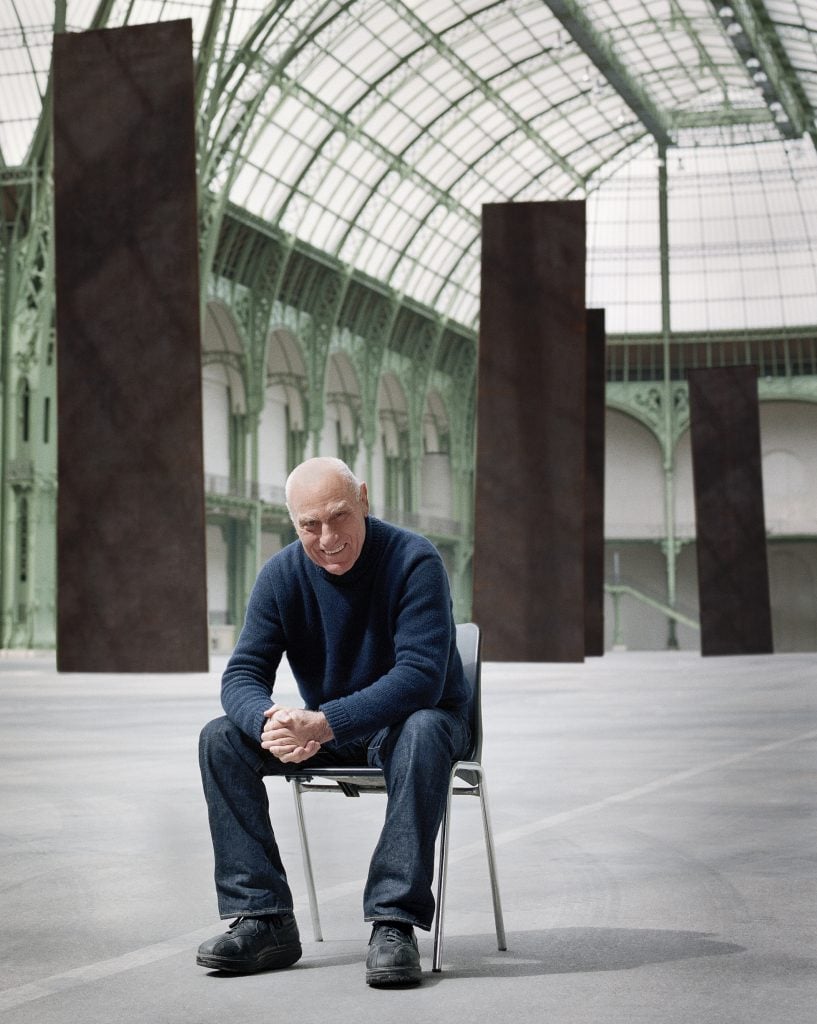
Just as he had a great artistic impact on many around him, Serra also made a deep personal impression.

Brian Boucher

The art world lost a titan on Tuesday with the passing of Richard Serra, known best for his towering sculptures in steel. His public works stand in cities throughout the world, while his sculptures have redefined gallery spaces from Dia:Beacon to the Guggenheim Bilbao. Among the plaudits he received was the Golden Lion at the 49th Venice Biennale in 2001.
Social media has come alive with tributes to the artist from dealers, curators, artists, and many other admirers and colleagues. We spoke with some of them. Their remembrances of the artist and appreciations of his work follow, along with some tributes from social media.
What was not immediately evident about Richard was his deep love for theater, dance, and poetry. He was a great supporter of the work of people that he believed in, often and particularly the work of women. Like many of us, he loved the landscape of Cape Breton, Canada. It was simply a wonderful experience to have known Richard for five decades, beginning with a fantastic trip to Japan.
Richard Serra was a giant in so many ways and he was only 5 foot 9. Gemini had the pleasure and privilege of continuously working with him for 52 years, producing over 330 fine art editions. Richard had an unbelievable storage of strength, coupled with a human kindness in every day of his life. This was the Richard I knew. When working with him, I often had the feeling there was a locomotive in the room, and if you wanted to survive, just get out its way. Sculpture has been redefined.
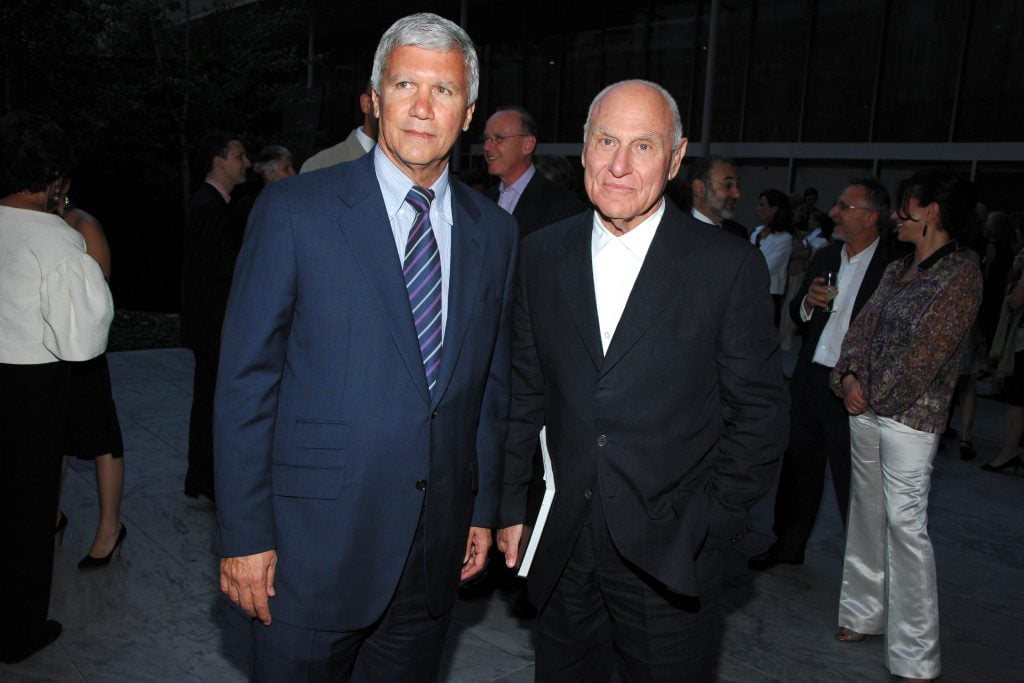
Larry Gagosian and Richard Serra at the Museum of Modern Art in New York, 2007. Photo: Billy Farrell/Patrick McMullan via Getty Images.
Richard Serra was a titan who transformed the very definition of sculpture and drawing. More than that, he changed us, how we see and feel our way toward an experience that is elemental and sublime. He put us at the center of his art. Before material, space, weight, and measure, it was our experience that he cared most about.
Our first exhibition together was in 1983 in Los Angeles and since then we worked on 40 exhibitions around the world dedicated to Richard’s work—every one of them a tough, exacting challenge, like their maker. Richard leaves a legacy of extraordinary care and empathy that we are not likely to see again. He was my friend and he will be greatly missed.
We met in 1969. Both Richard Bellamy and Leo Castelli had mentioned that I should absolutely meet him (I was, at the time, a very young art journalist). Richard was about to start working on a project at Leo’s uptown warehouse, something that could not fit in a typical gallery space. He was looking for assistants to help him, and I enthusiastically volunteered, together with Phil Glass.
We generally started around mid-morning, moving heavy plates of steel to balance them somewhat in the mode of a house of cards, and the whole process was always participative. It is in this space that he did his projections of melted lead, stretching the limits of safety.
During pauses, Richard would talk passionately about sociopolitical issues (McLuhan, Chomsky…) and cultural issues, including music (John Cage, Lamonte Young…) and dance (Judson Dance Theater, Yvonne Rainer…). He spoke relatively little about his own work, except on practical terms, with the one exception being his list of transitive verbs that kept growing.
When I took on the editorship of Arts Magazine, I gave him carte blanche to do something, and he showed photographs of a rare ephemeral piece he did on snow-covered mountain slopes.
Richard always struck me as someone who stretched the limits and took risks. I’ll always remember a show of his at Castelli’s raw alternative space on Greene Street in the mid-80s: he installed a huge steel plate that cut the space diagonally in two… and that finally went right through the floor because of its weight. However, when an accident crushed and killed one of his assistants, it was quickly proven that it was not due to a mistake of his.
When I quit writing about art to go back to painting, we remained close friends and he came to my studio to see my work more than once, always with an open mind.
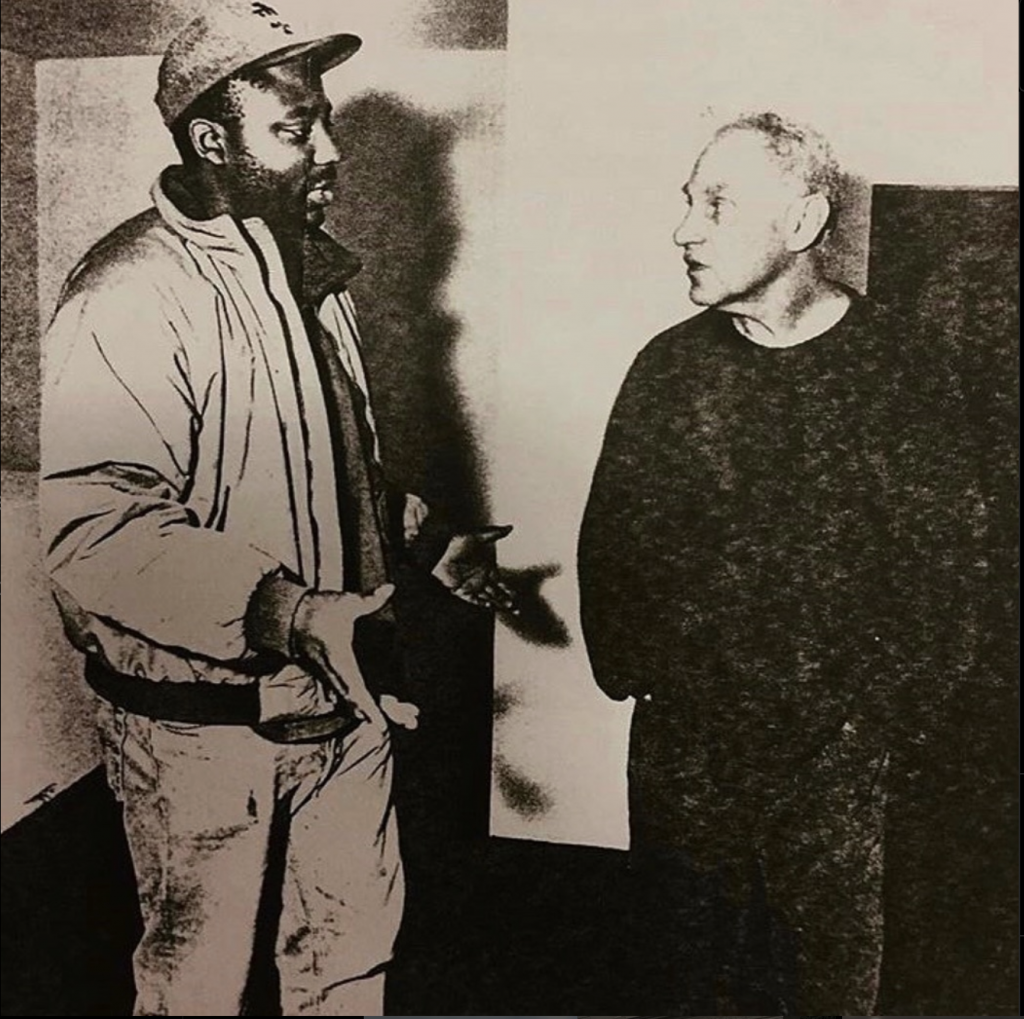
Rico Gatson with Richard Serra. Courtesy Rico Gatson.
This picture was taken at my thesis exhibition at Yale School of Art in 1991 when I met Richard Serra. He really responded well to the work and asked what I planned to do after graduation. I said I might move back to California. He said you need to come to New York—all young artists should be there. I said if I do will you hire me. He gave me his phone number and said call me when you get there. I did and spent two plus years in his world working on drawings and assisting his assistant Allen. He even gifted me and Julie $200 for our wedding. That was a lot of money back then. There are other stories of his generosity. That was a long time ago now but the experience shaped me in so many ways. Thank you, Richard. Rest well, you giant of an artist.
Richard Serra’s six decades long career irrevocably changed our understanding of what sculpture is and may be. Beginning with the Torqued Ellipses in the later 1990s, his work pivoted from an earlier vanguard practice centered on the interaction of processes and materials. By contrast, the monumental sculptures of his last decades, arcing, twisting plates of Corten steel, shape and orchestrate viewers’ experiences of space in unprecedented ways. Responding bodily and psychically to their charged impact, many viewers invoke feelings of the sublime.
View this post on Instagram
A post shared by Thomas Hirschhorn (official) (@thomashirschhorn_official)
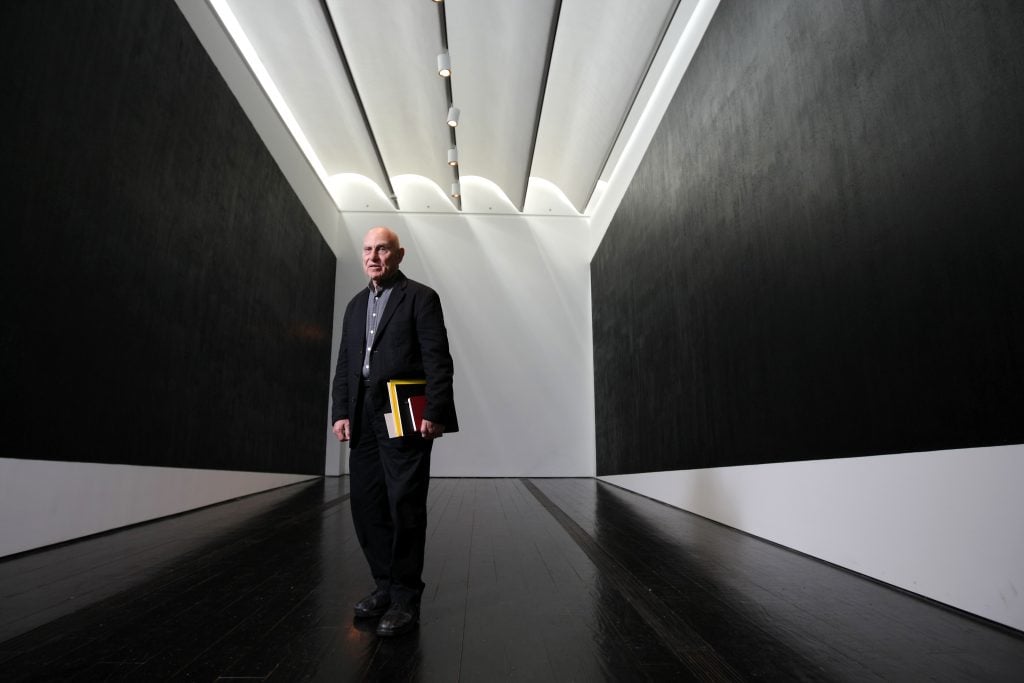
Richard Serra at “Richard Serra Drawing: A Retrospective” at the Menil Collection in Houston, 2012. Photo: Nick de la Torre/Houston Chronicle via Getty Images.
In 2011–12, I co-curated a retrospective of Richard Serra’s drawings at the Menil Collection, SFMOMA and the Metropolitan Museum of Art. The rigor Richard applied to all aspects of exhibition planning was inspiring—from his sensitivity to the gallery’s architecture to his investment in the scholarship. He was always looking and always had a drawing notebook under his arm. He responded to his experiences by making a mark, and the world around him never ceased to be of deep interest. Over a decade has passed, and as we move even further from the legacies of modernism that the artist so brilliantly pushed against, I am still astounded at the relevancy of his physical work. It is all about being present. It is about the primacy of the moving and feeling body and the condition of being in this world. In a commencement speech, he advised graduates at Williams College to “not let the rhetoric of simulation steal away the intimacy of your experience. Keep it real, keep it in the moment.” Indeed, what could be more applicable in our increasingly virtual landscapes?
I am sad to hear of Richard Serra‘s passing. He was the last of a certain era. He was uncompromising, rigorous, and unwilling to take part in anything that did not pertain to his practice as an artist. His singular vision of an object in space, of weight and mass, is central to what it means to make sculpture. His works sit between meaning and object. Never falling into the banality of meaning and always allowing the object poetic presence.
Everyone focuses on Serra’s expansive raw steel sculptures and compact body. I was more awed by his intellect. When I interviewed Serra for his recollections of his close friend Robert Smithson, sitting in the dim living room of his Tribeca home nursing tea in fine china, what gave me joy was his articulate thoughtfulness. For one making work demanding bodily engagement, a kind of aesthetic extroversion, his speech displayed a reflective interiority that I didn’t expect. Oh, he identified with being ardently ambitious, describing his cohort in barren downtown lofts in the mid-1960s as believing that if an artist sold out a show, it demonstrated that the work was too easily understood and commodified. The galleries didn’t have a “stranglehold,” and there was a family feeling among the society of artists. Serra had been an English major at University of California Santa Barbara, and it showed: he told me to read Cormac McCarthy’s Blood Meridian because it had reminded him of Smithson’s attraction to the topic of death and morbid situations—“a brilliant book, beautifully written, but difficult.”
So what was his appeal to Smithson? “I think he liked my wit, my intelligence, my humor, the fact that I could laugh at him and we could laugh at each other—the fact that I wasn’t scared of him like other people. He was right—I wasn’t.”
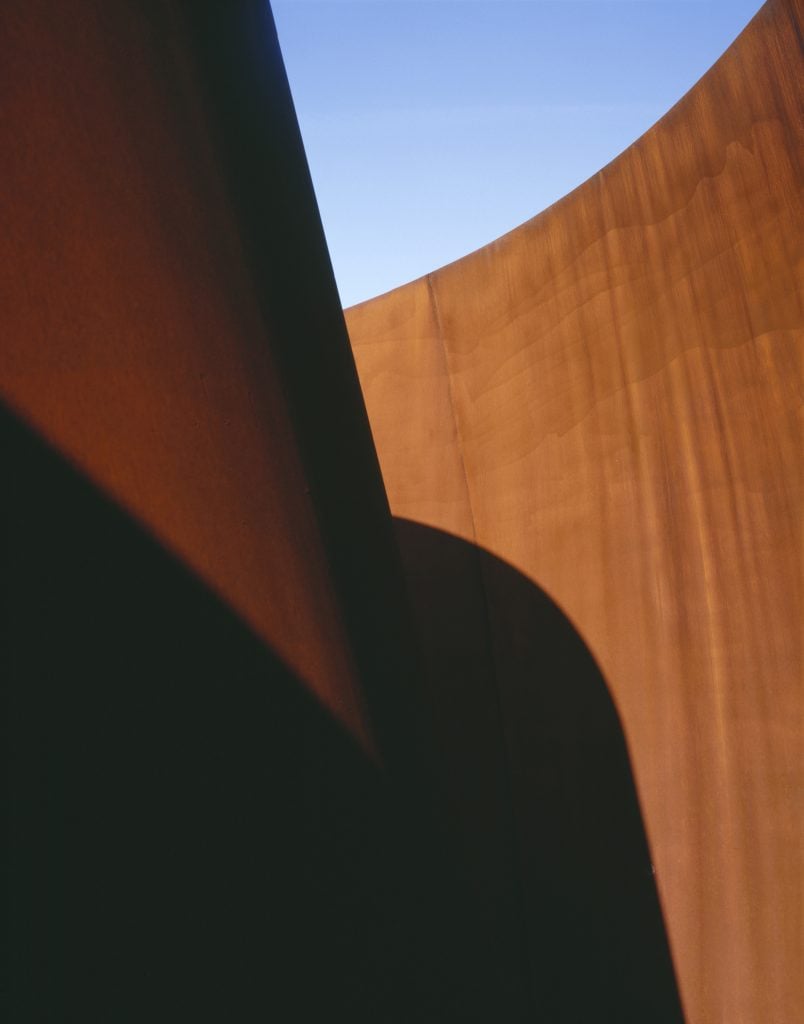
Detail of iron sculpture by Richard Serra at the Pulitzer Foundation For The Arts, St Louis. Photo: View Pictures/Universal Images Group via Getty Images.
My favorite experience of a Serra sculpture was in St Louis, at the Pulitzer Arts Foundation. In close dialogue with the founder, Emmy Pulitzer, and the architect, Tadao Ando, Serra made a massive Cor-ten work titled Joe, so named after the late Joe Pulitzer Jr., with whom the artist had a long history. Serra placed the object just so that when Emmy Pulitzer sat at her desk in her museum office, she could see the upper surface of the spiraling metal structure exactly from her window. The lines, as seen from that vantage point, were exquisite and, unlike the hulking steel, they were gentle, fragile, lyrical. That combination of monumentality and intimacy is what I always admired about Serra’s work. No matter how many tons these enormous things weighed, they managed to express and evoke something distinctly personal.
The MCA has enjoyed a long relationship with Richard Serra, presenting his work over 20 times dating back to 1969 with the exhibition “Art by Telephone,” and holding multiple works in its collection. It is hard to understate the singularity and importance of Serra, whose career profoundly shaped the way we understand material and physical space. His work is foundational in any discussion of contemporary sculpture and will remain a significant and enduring influence on artists for generations.
Public Art Fund collaborated with Serra on the exhibition of two groundbreaking works in the 1980s. First, St. John’s Rotary Arc, a site-specific 200-foot arc-shaped steel sculpture at the center of the Holland Tunnel rotary in Tribeca. Then T.W.U., a sculpture named in honor of the Transit Workers Union, consisting of three 12-by-36-foot steel plates weighing a combined 72 tons, was exhibited near the Franklin Street subway station. Both works powerfully exemplify the fundamental shift from studio-based production to industrial fabrication at an epic scale, combining architecturally scaled formal elegance with raw physical energy.
Richard Serra’s sculptures installed at Dia Beacon. Photo: Johannes Schmitt-Tegge/picture alliance via Getty Images.
Richard Serra has been a vital presence in Dia’s history, particularly to Dia Beacon, where his Torqued Elipses have long been an essential part of any visit. These works captivate visitors with their labyrinthine monumentality, disrupting one’s perception of space and form as they navigate through them, evoking both physical and emotional responses. Serra’s impact on modern sculpture is profound, and his legacy will endure for generations to come.